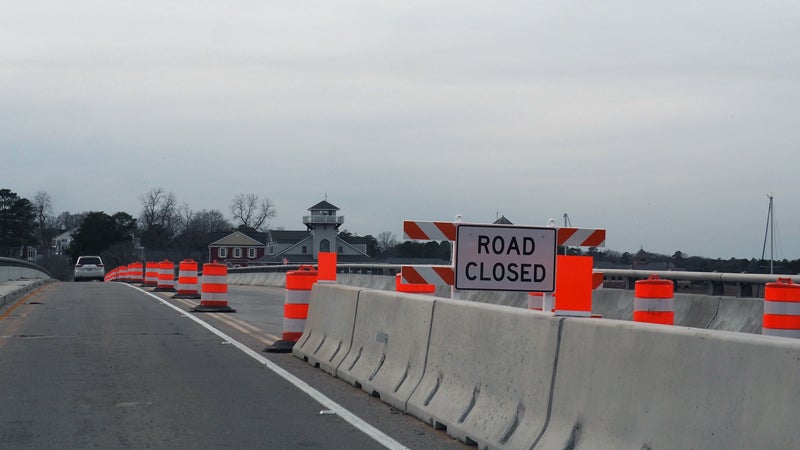What’s driving the two-year Cypress Creek Bridge timeline?
Published 6:58 pm Wednesday, April 17, 2024

- The Cypress Creek Bridge is restricted to one-way traffic for the duration of VDOT's nearly two-year rehabilitation. (File photo)
The Virginia Department of Transportation’s nearly two-year timeline for rehabilitating the Cypress Creek Bridge is one of the longest Isle of Wight County has seen in recent history, but what’s driving it?
Since January, the circa-1975, 1,500-foot-long bridge that connects downtown Smithfield with the east end of town has been restricted to a single westbound lane. Until the project’s estimated fall 2025 completion date, eastbound motorists are to use the Route 10 Bypass to leave town, a detour that’s seen frequent bumper-to-bumper rush hour traffic over the past four months. Prior to the restriction, the bridge saw an estimated 12,000 vehicular trips daily.
VDOT projected a similar 20-month reconstruction timeline in March 2016 when it demolished the circa-1936 Carrsville Highway Bridge through southern Isle of Wight County that connects Suffolk with Franklin.
The 2017-completed, roughly 1,800-foot-long replacement Carrsville Community Memorial Bridge, which sees an estimated 2,900 vehicles daily, opened to traffic in August of that year, three months ahead of schedule.
In 2022, VDOT restricted the shorter but wider four-lane Route 460 Bridge over the Blackwater River that connects Isle of Wight and Southampton counties to one eastbound and one westbound lane for eight months to facilitate repairs to the circa-1987 structure that included new composite concrete decking and parapets. The bridge reopened on schedule in November of that year.
VDOT has cautioned against drawing any conclusions from a comparison of the Cypress Creek Bridge timeline to seemingly similar projects.
“Differences in construction timelines at different structures cannot be accurately compared, without extensive research, as the determining factors vary too widely between locations,” said VDOT spokeswoman Kelly Alvord.
Crofton Construction, the Portsmouth-based contractor VDOT awarded the $8.6 million Cypress Creek contract in September, officially began the project’s construction phase on Dec. 4 though the restricted travel didn’t begin until Jan. 22. The work includes underwater pile repairs, the demolition and replacement of multiple bridge spans, the repainting of steel beams, and replacing the bridge’s sidewalk and barriers.
“This particular project also involves the innovative utilization of a longer-life carbon fiber reinforced polymer strands for the beams that serves to lessen the normal deterioration of underwater piles when exposed to marine conditions,” Alvord said.
Part of what’s driving the fall 2025 completion date is limited work hours to maintain one-way travel and reduce impacts on nearby residents and businesses. Bridge and road projects that don’t have to maintain vehicular and pedestrian traffic can have a shortened construction timeline, as crews can work simultaneously on various tasks and stage equipment and supplies on the bridge surface, Alvord said.
VDOT’s phased approach to bridge repairs, according to the agency’s website, begins long before anyone ever sees orange cones on the road. VDOT evaluated three options during the project’s design phase: closing the bridge entirely, maintaining two-way traffic via a temporary traffic signal, and the one-way westbound option VDOT ultimately chose in December based on the urging of the Town of Smithfield and Isle of Wight County to minimize the project’s impact on fire and ambulance response times.
Other factors that can extend a project’s estimated time to completion, Alvord said, include the need to construct temporary structures or work platforms for site access, the nationwide supply chain shortages and delays that have persisted since the height of the COVID-19 pandemic and weather-related impacts like high water at the bridge.
The first of four planned five-day closures of both bridge lanes, which was originally to last April 8-12, finished a full 3½ days early on April 9.
According to Alvord, Crofton’s contract includes a cash incentive to finish the work early. VDOT has agreed to pay Crofton an extra $4,000 per day the project is completed ahead of schedule, capped at $180,000, and a $4,000 per day penalty, capped at $360,000, for each day past the deadline the work goes unfinished.
Editor’s note: This story is updated to include information on cash incentives for the contractor to finish early, and disincentives for finishing late.





